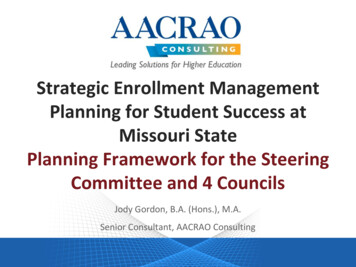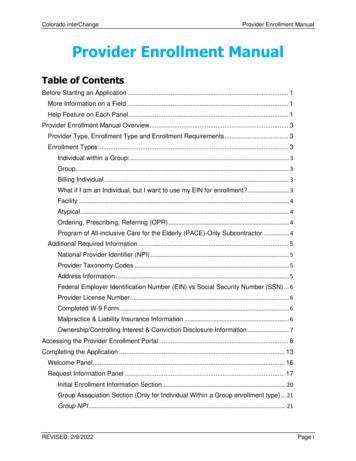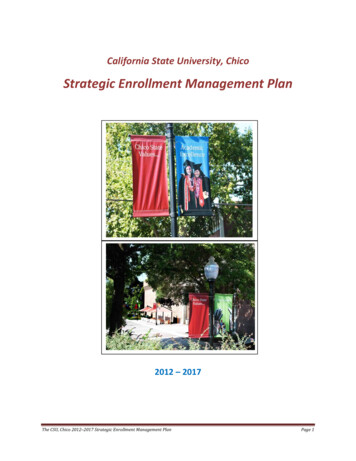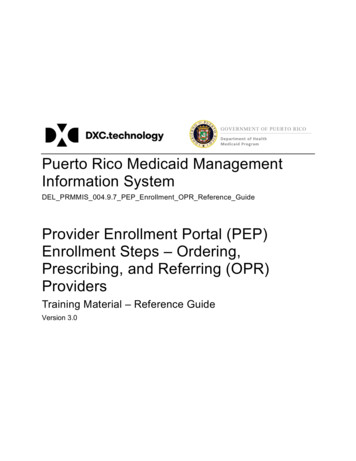
Transcription
Strategic Enrollment ManagementPlanning for Student Success atMissouri StatePlanning Framework for the SteeringCommittee and 4 CouncilsJody Gordon, B.A. (Hons.), M.A.Senior Consultant, AACRAO Consulting
Outline for the Workshop1. Why talk Student Success with SEM?2. Knowing our Students – Building towards Principles for StudentSuccess3. Planning Framework for our Student Success Plan (or StrategicEnrollment Management Plan) – Guiding Principles to drive ourenrollment goals for the next 5 years4. What’s up next?Missouri State Student Success Planning2
Why are we here? SEM Defined asStudent Success“Strategic Enrollment Management is a concept and processthat enables the fulfillment of institutional mission andstudents’ educational goals.” Bob Bontrager“Strategic Enrollment Management is a comprehensiveprocess designed to help an institution achieve and maintainthe optimum recruitment, retention, and graduation ratesof students, where “optimum” is defined within theacademic context of the institution. As such, SEM is aninstitution-wide process that embraces virtually every aspectof an institution’s function and culture.” Michael DolenceMissouri State Student Success Planning3
Why Talk about SEM with Student Success?Well SEM is 1. Strategic and intentional2. Practical, tangible planning process3. Data- and goal-driven4. Action-oriented5. Cross-campus participation6. Rallying point for the campus which results in Enrollment success and success forstudents during the entire lifecycle!Missouri State Student Success Planning4
Student Success, Not Retention, Why?1. Retention is clinical rather than aspirational2. Retention is merely a measurement, a benchmarkof educational attainment3. And often, as John Gardner would argue, aminimum one at that: Retention is a C- and apulse4. Retention restrains us, limits our vision and ourcapacity for creativity and excellenceMissouri State Student Success Planning5
Student Success Defined"[E]mpower students to succeed through educationallypurposeful activities, initiatives, and accountabilitymeasures that will ensure that students are retained andgraduated at higher than predicated rates, with higherdegrees of satisfaction and minimal financialindebtedness, and are employed or enter graduate,professional, post-secondary programs at higher rates,having acquired the skills, knowledge and dispositionsto succeed in any of those endeavors they pursue.”Strategic Enrollment Management: Transforming Higher Education (2012), p. 58Missouri State Student Success Planning6
What Will It Take to Build Success?1. Core values that support a set of assumptions about a comprehensive,integrated, and coordinated approach2. Programs and services designed with intentionality, purpose,integration of effort, service efficiency, and positive interventions withstudents3. Integrated cross-campus collaborations and partnerships betweenfaculty, staff, and administration oh and students!4. Use of assessment and data for informed decision making5. Understanding of how campus cultures impact Enrollmentmanagement effortsMissouri State Student Success Planning7
But Remember 1. There are NO SILVER BULLETS! There is no template, one-size-fits-allmodel that ensures student success2. Campuses have to move from “Enrollment by chance” to “Enrollment bydesign” to achieve student success3. To do that, strategic Enrollment planning has to first understand andthen become part of the culture of the entire campus4. Only then can there be clear goals and efforts for optimal Enrollment tofulfill institutional mission and services and programs to improve studentlearning and success – a fulsome SEM Plan!Missouri State Student Success Planning8
SEM for Student SuccessThe purpose of SEM is achieved by:1. Establishing clear goals for the number and types of students neededto fulfill the institutional mission2. Promoting students’ academic success by improving access, transition,persistence, and graduation3. Promoting institutional success by enabling effective strategic andfinancial planning4. Creating a data-rich environment to inform decisions and evaluatestrategies5. Improving process, organizational and financial efficiency, andoutcomes6. Strengthening communications and collaboration across the campus—especially between institutional leaders and instructionMissouri State Student Success Planning9
SEM Perspective of Student SuccessRecruitment larSupportDegree/GoalAttainmentStudent’s College/University ntionBontrager, 2004Missouri State Student Success Planning10
The Cost of Attrition – When a studentdrop-outs/stops-out Aside from the costs to the individual student(loss of time in the workforce, reduced selfesteem, financial loss) and loss to the communityin which the student wishes to live and work (lossof a knowledgeable employee) there are real coststo the institution: Financial impactReputational impactAccreditation impactRetained Student experience impactMissouri State Student Success Planning11
Knowing our StudentsMissouri State Student Success Planning12
The nextgenerationCollegestudentMissouri State Student Success Planning13
Student Success starts by knowing ourstudentsOur current students 1. Underrepresented students declining2. International students declining3. Our students are graduating earlier4. Transfer student population is declining5. High School graduates not increasing6. Graduate students are increasing7. Retention has remained steady8. And we have a large % of First Generation and Pell eligiblestudentsMissouri State Student Success Planning14
Principles of Student SuccessTotal Community Effort involving both internal and external resourcesMissouri State Student Success Planning16
Principles of Student SuccessTeaching Excellence/Engaged FacultyMissouri State Student Success Planning17
Principles of Student SuccessOpportunities for Service Learning, Work-Integrated Learning,Undergraduate Research, and Experiential LearningMissouri State Student Success Planning18
Principles of Student SuccessSupportive Services that are streamlined and designed based upon thelifecycle of the studentMissouri State Student Success Planning19
Student Success Strategies1. Understanding why students stay and why they leave2. Identifying institutional areas for improvement that mustbe addressed to improve student learning and success3. Identifying academic transitional services that meet theneeds of students4. Identifying social/personal development services thatmeet the needs of students5. Creating partnerships and collaborations across campusfocusing on improving student learning and successthrough sound strategic planningMissouri State Student Success Planning20
Student Success Plan As Partof our Integrated PlanningMissouri State Student Success Planning21
Integrated Strategic Planning forStudent SuccessFacilitiesMasterPlanInstitutional StrategicPlan – Vision andMissionLong Range PlanSEM issouri State Student Success Planning22
Our SEM Planning FrameworkSustainableEnrollmentOutcomes andStudent SuccessAssessmentTacticsStrategiesKey Performance IndicatorsStrategic Enrollment GoalsData Collection and Analysis/ScanInstitutional Strategic PlanØ Clarity of institutionalmission, vision, goalsØ Long Range PlanØ Strategic directionØ Aggregate enrollment goalsKerlin/Smith, 2018, adaptedfrom Green/Bontrager, 2004Missouri State Student Success Planning23
SustainableEnrollmentOutcomes andStudent SuccessAssessmentTacticsStrategiesKey Performance IndicatorsStrategic Enrollment GoalsData Collection and Analysis/ScanInstitutional Strategic PlanØ Internal benchmarks: KPInumbers over the past 3-5yearsØ Environmental scan Demographics Economics Market opportunities CompetitionØ Institutional research plan:designated reports andproduction scheduleKerlin/Smith, 2018, adaptedfrom Green/Bontrager, 2004Missouri State Student Success Planning24
SEM Model: Data“Track relentlessly what works and what doesn’t.”--Slippery Rock University“Data is not the plural of anecdote.”--Scannell & Kurz“Without Data you’re just another person with anopinion.”--UnknownMissouri State Student Success Planning25
SEM Model: DataWhere to start?1. What issues are key to our institution NOW?2. What issues are on the horizon?3. Environmental Scan/SWOT Analysis4. Data points to consider: Enrollment basics: Headcount, FTE, demographics, enrollment statusCourse offerings (capacity, trends, wait lists)Retention data (and defining retention!)Financial aid5. Budget planning6. Program cost analysis and accreditation processes. . . or whatever best fits our institution!Missouri State Student Success Planning26
SEM Model: DataOur Guiding Principles can be our data starting point Stabilize enrollment short termGrow enrollment in targeted areasImprove retentionFacilitate successful degree and credential completionBroaden access to underserved populationsIdentify new and emerging academic programing that meetsstudent and workforce demandsEquip students for successful career outcomesEmploy actions and modify processes that eliminate barriers thatimpair student success.Raise the profile of the UniversityDevelop a culture of enrollment growth among faculty, staff, andstudentsMissouri State Student Success Planning27
SEM Model: DataIt is so easy to gostraight to “strategies.”But you should do yourhomework first andstart at the beginningwith data. . .1. Accessibility of data2. Getting everyone on the same page3. Confirms or disproves campus “urban legends”4. Confirms or disproves anecdotal “facts”5. Information gathered to make decisions will be used for actuallymaking decisions6. Define a stopping point or “phase II” questions7. Avoid the strategy discussion: Create a “parking lot”8. Relevant vs. interesting data9. Tells the story of the institution through its environment (external andinternal) and its enrollment historyMissouri State Student Success Planning28
SustainableEnrollmentOutcomes andStudent SuccessAssessmentTacticsStrategiesKey Performance IndicatorsØ 5-10 year Strategicenrollment targetsØ Focus: the institution’sdesired futureØ Based on: mission, data,and environmental scanningStrategic Enrollment GoalsData Collection and Analysis/ScanInstitutional Strategic PlanKerlin/Smith, 2018, adaptedfrom Green/Bontrager, 2004Missouri State Student Success Planning29
Goals, Strategies, and Tactics: There IS aDifference1. Goals: Big Picture (6-8 broad statements/targets, divided betweenrecruitment and retention; 3-4 additional for grad); driven byStrategic Plan, input from campus leadership, developed by steeringCommittee, often, or by the Recruitment and Retention teams2. Strategies: Narrower action statements (usually 3-4 per goal) thatgive a framework for achieving the goals. These are umbrellastatements that suggest direction without all the details, driven bythe three SEM Plan committees with approval from SteeringCommittee3. Tactics: Specific actions/programs that make up the road map ofhow you get there (usually 3-5 per strategy). Driven by the threecommittees with input and approval from Steering CommitteeMissouri State Student Success Planning30
Important points about Enrollment Goals1. These should emerge from the environmental scan,enrollment behavior research, enrollment models and yourATD plans.2. Goals should be specific and focused:– Name the enrollment segment– Declare the starting point– Declare the desired state or ending point3. Goals should be limited:– Aim for three to four recruiting/marketing goals andthree to four retention/completion/student success goalsMissouri State Student Success Planning31
When a goal is not a goal without dataEnrollment GoalImprove retention (a guiding principle!)Enrollment Goal with DataIncrease retention of first year first timeundergraduate baccalaureate students from yearone to year two from 78% to 80% by 2025.Missouri State Student Success Planning32
SustainableEnrollmentOutcomes andStudent SuccessAssessmentTacticsStrategiesKey Performance IndicatorsStrategic Enrollment GoalsData Collection and Analysis/ScanInstitutional Strategic PlanØ Student categories: firstyear, transfer, graduate,certificate, continuing ed,face-to-face/online, etc.Ø Desired student groups:racial/ethnic diversity,academic ability, specialskills, family incomeØ Geographic origin: local,regional, national,internationalØ Recruitment, retention,completion ratesØ Institutional capacityKerlin/Smith, 2018, adaptedfrom Green/Bontrager, 2004Missouri State Student Success Planning33
SEM Model: KPI’sThe Student Success nBontrager, 2004Missouri State Student Success Planning34
SustainableEnrollmentOutcomes andStudentSuccessAssessmentTacticsStrategiesKey Performance IndicatorsStrategic Enrollment GoalsØ Campus Infrastructure:Ø Staffing: skill sets,strategic deploymentand structureØ Systems: policies,procedures, technologyØ Capacity for makingeffective enrollmentdecisions: positions,reporting lines,committeesData Collection and Analysis/ScanInstitutional Strategic PlanKerlin/Smith, 2018, adaptedfrom Green/Bontrager, 2004Missouri State Student Success Planning35
SustainableEnrollmentOutcomes andStudentSuccessAssessmentTacticsStrategiesKey Performance IndicatorsStrategic Enrollment GoalsData Collection and Analysis/ScanInstitutional Strategic PlanØ Increase new students ofspecified typesØ Increase retention rates,specifically by studenttypesØ Expand into new marketsØ Utilize emergingtechnologiesØ Financial aid/scholarshipsØ Academic programs: mixand delivery systemsKerlin/Smith, 2018, adaptedfrom Green/Bontrager, 2004Missouri State Student Success Planning36
Ø Marketing/branding initiativesSustainableEnrollmentOutcomes andStudent SuccessØ Organizing academicprogramsØ Multilingual recruitmentmaterialsAssessmentØ Targeted interventions forstudents in high risk coursesTacticsØ Enhanced academic advisingStrategiesØ Streamlined admissionproceduresKey Performance IndicatorsØ Purchasing a new CRMsystemStrategic Enrollment GoalsØ Degree audit softwareData Collection and Analysis/ScanInstitutional Strategic PlanKerlin/Smith, 2018, adaptedfrom Green/Bontrager, 2004Missouri State Student Success Planning37
SustainableEnrollmentOutcomes andStudent SuccessAssessmentØ Consistently meetinggoals over the long term Enabling more effectivecampus-wide planningTactics Revisions to theinstitutional strategic planStrategies Academic planning:curriculum, faculty needsKey Performance IndicatorsStrategic Enrollment GoalsData Collection and Analysis/ScanInstitutional Strategic Plan Facility planning Financial planningØ Achieving the institution’sdesired futureKerlin/Smith, 2018, adaptedfrom Green/Bontrager, 2004Missouri State Student Success Planning38
Hierarchical relationship of goals, strategiesand tacticsWhere the College aspires to be inthe futureVision/MissionHow your enrollment segments mustchange to meet your ersionGoalsThe major strategies required to meetyour goalsRecruitmentstrategy 1Recruitmentstrategy 2Conversionstrategy 3Retentionstrategy 1Retentionstrategy 2ConversionStrategy 3The operational plans to implementand sustain your rsiontactics(multiple)Missouri State Student Success Planning39
What’s Next? Linking, Integrating andExtending1. Workshop with the Data team– What do we know from our Data? – SWOT Analysis – LINKING2. Development of the Strategic Enrollment Goals with 4 Councils– What stories emerged from our Data and SWOT? –INTEGRATING– Development of the Enrollment Goals – EXTENDING3. Matching existing strategies and tactics to achieving those goals(inventory) and Development of new strategies and tactics tofurther achieve those goals – The “Living” part of the documentMissouri State Student Success Planning40
Our SEM Plan Recommendationv Our Student Success SEM Plan provided in draft to SeniorLeadership April 2020 and released in June 2020 shouldinclude vvvvvPlanning FrameworkEnvironmental ScanCommittee StructureOur Strategic Enrollment Goals with targetsOur Strategies for achieving those Goalsv Tactics and Action Plans follow final approval of the plan – ourliving documentMissouri State Student Success Planning41
Student Success Planning Tasks Timeline1. Review internal enrollment and external environment data – today withData Team2. Create 6-8 focused draft enrollment goals with targets – tomorrow with 4Councils; approval by Senior Leadership by mid-December3. Create and align strategies – due in draft to Senior leadership April 2020– May have multiple strategies for each goal and some strategies may supportmore than one goal– Councils Recommend to Steering for feedback and approval by February 20204. Create and align tactics that support each strategy by June 2020– May have multiple tactics for each strategy and some tactics may support morethan one strategy– Recommend to Steering for feedback and approval ongoing5. Create actionable work plans for our strategies/tacticsMissouri State Student Success Planning42
1.There are NO SILVER BULLETS! There is no template, one-size-fits-all model that ensures student success 2.Campuses have to move from "Enrollment by chance" to "Enrollment by design" to achieve student success 3.To do that, strategic Enrollment planning has to first understand and then become part of the culture of the entire campus










